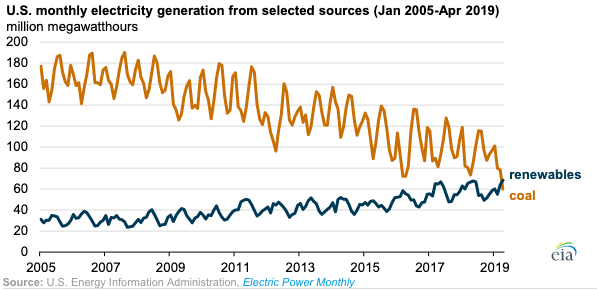
Renewable electricity beat out coal for the first time in April

A remarkable thing happened in the US in April. For the first time ever, renewable electricity generation beat out coal-fired electricity generation on a national level, according to the Energy Information Agency (EIA). While renewable energy—including hydro, wind, solar, geothermal, and biomass—constituted 23 percent of the nation’s power supply, coal-fired electricity only contributed 20 percent of our power supply.
There are seasonal reasons for this happening in April. Wind power generation tends to be higher in spring and fall, hydroelectric generation usually peaks as winter snow melts, and lengthening days mean more solar power can be fed to the grid.
In addition, people use less electricity in spring, as it’s not cold enough to need a lot of heating and not warm enough to require lots of air conditioner use. Coal-fired power plant owners, expecting this low demand, often use spring and fall to take their power plants offline for regularly scheduled maintenance.
Still, there’s a reason that renewables surpassed coal this spring, and not in previous springs, as the graph below shows. Coal-fired power plants are being retired at record rates, and renewable energy, while slower to rise than coal is to fall, is picking up the slack.

According to the EIA, more than 15 gigawatts of wind and solar power were added to the US national grid in 2018, paving the way for a situation where “record generation from wind and near-record generation from solar contributed to the overall rise in renewable electricity generation this spring.”
In April 2019, wind generation across the US provided 30.2 million megawatt-hours (MWh) of electricity, more than ever before.
That said, the EIA predicts that it’s unlikely that renewables will outperform coal again this year, and it expects that coal will continue to provide more electricity than renewables over the year as a whole this year and in 2020. But coal’s share continues to drop. In 2018, coal only provided 27.5 percent of the US electricity supply over the whole year. Considering that as recently as the year 2000, coal-fired generation accounted for a peak of 52 percent of the nation’s power supply (PDF), that’s quite a dramatic turnaround.
One thing to keep in mind, however: coal’s demise has many environmental benefits, including reductions in particulate and sulfur oxides pollution as well as better health for those who once lived near coal plants. But fewer coal plants have not been translating to reductions in carbon dioxide emissions in the US. In fact, the boom in new natural gas plants around the country has more than made up for coal retirements in terms of carbon dioxide emissions. If we’re going to take on climate change in an expeditious manner, cheap natural gas will have to be the next target.




